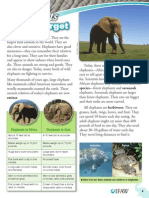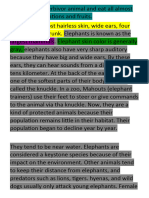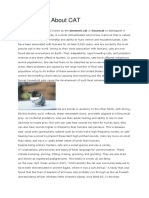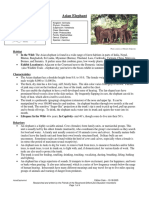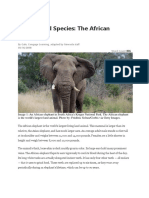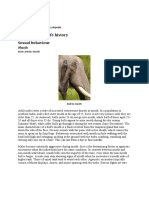0 ratings0% found this document useful (0 votes)
38 viewsResearch Paper On Elephant
Research Paper On Elephant
Uploaded by
neerajElephants are the largest existing land animals and belong to the family Elephantidae. There are three living elephant species: the African bush elephant, African forest elephant, and Asian elephant. Elephants are found throughout parts of Africa and Asia, and live in various habitats near water. They have a complex social structure, with females and young living in family groups led by the oldest female, while males leave their family group at maturity. Elephants communicate through touch, sight, sound and smell over long distances and display intelligence and empathy.
Copyright:
© All Rights Reserved
Available Formats
Download as DOCX, PDF, TXT or read online from Scribd
Research Paper On Elephant
Research Paper On Elephant
Uploaded by
neeraj0 ratings0% found this document useful (0 votes)
38 views2 pagesElephants are the largest existing land animals and belong to the family Elephantidae. There are three living elephant species: the African bush elephant, African forest elephant, and Asian elephant. Elephants are found throughout parts of Africa and Asia, and live in various habitats near water. They have a complex social structure, with females and young living in family groups led by the oldest female, while males leave their family group at maturity. Elephants communicate through touch, sight, sound and smell over long distances and display intelligence and empathy.
Original Description:
Life of Elephant
Original Title
Research paper on Elephant
Copyright
© © All Rights Reserved
Available Formats
DOCX, PDF, TXT or read online from Scribd
Share this document
Did you find this document useful?
Is this content inappropriate?
Elephants are the largest existing land animals and belong to the family Elephantidae. There are three living elephant species: the African bush elephant, African forest elephant, and Asian elephant. Elephants are found throughout parts of Africa and Asia, and live in various habitats near water. They have a complex social structure, with females and young living in family groups led by the oldest female, while males leave their family group at maturity. Elephants communicate through touch, sight, sound and smell over long distances and display intelligence and empathy.
Copyright:
© All Rights Reserved
Available Formats
Download as DOCX, PDF, TXT or read online from Scribd
Download as docx, pdf, or txt
0 ratings0% found this document useful (0 votes)
38 views2 pagesResearch Paper On Elephant
Research Paper On Elephant
Uploaded by
neerajElephants are the largest existing land animals and belong to the family Elephantidae. There are three living elephant species: the African bush elephant, African forest elephant, and Asian elephant. Elephants are found throughout parts of Africa and Asia, and live in various habitats near water. They have a complex social structure, with females and young living in family groups led by the oldest female, while males leave their family group at maturity. Elephants communicate through touch, sight, sound and smell over long distances and display intelligence and empathy.
Copyright:
© All Rights Reserved
Available Formats
Download as DOCX, PDF, TXT or read online from Scribd
Download as docx, pdf, or txt
You are on page 1of 2
Elephant
Elephants are a select group of proboscideans belonging to the
family Elephantidae. They are the largest existing land animals. Three
living species are currently recognised: the African bush elephant, the African forest
elephant, and the Asian elephant. Elephantidae is the only surviving family of
proboscideans; extinct members include the mastodons. The family Elephantidae
also contains several extinct groups, including the mammoths and straight-tusked
elephants. African elephants have larger ears and concave backs, whereas Asian
elephants have smaller ears, and convex or level backs. Distinctive features of all
elephants include a long proboscis called a trunk, tusks, large ear flaps, massive
legs, and tough but sensitive skin. The trunk is used for breathing, bringing food and
water to the mouth, and grasping objects. Tusks, which are derived from the incisor
teeth, serve both as weapons and as tools for moving objects and digging. The large
ear flaps assist in maintaining a constant body temperature as well as in
communication. The pillar-like legs carry their great weight.
Elephants are scattered throughout sub-Saharan Africa, South Asia, and Southeast
Asia and are found in different habitats, including savannahs, forests, deserts,
and marshes. They are herbivorous, and they stay near water when it is accessible.
They are considered to be keystone species, due to their impact on their
environments. Elephants have a fission–fusion society, in which multiple family
groups come together to socialise. Females (cows) tend to live in family groups,
which can consist of one female with her calves or several related females with
offspring. The groups, which do not include bulls, are usually led by the oldest cow,
known as the matriarch.
Males (bulls) leave their family groups when they reach puberty and may live alone
or with other males. Adult bulls mostly interact with family groups when looking for a
mate. They enter a state of increased testosterone and aggression known as musth,
which helps them gain dominance over other males as well as reproductive success.
Calves are the centre of attention in their family groups and rely on their mothers for
as long as three years. Elephants can live up to 70 years in the wild.
They communicate by touch, sight, smell, and sound; elephants use infrasound,
and seismic communication over long distances. Elephant intelligence has been
compared with that of primates and cetaceans. They appear to have self-awareness,
and appear to show empathy for dying and dead family members.
You might also like
- Answer Key Lab Diffusion and OsmosisDocument8 pagesAnswer Key Lab Diffusion and OsmosissabrinaNo ratings yet
- Drinking Water Fountain (SOCO-40) - Part List & ManualDocument9 pagesDrinking Water Fountain (SOCO-40) - Part List & ManualZdravko Eta LovicNo ratings yet
- Elephants Are The Largest Existing Land Animals. ThreeDocument1 pageElephants Are The Largest Existing Land Animals. ThreeCristi CrissNo ratings yet
- Elephants Are The Largest Existing Land Animals. ThreeDocument1 pageElephants Are The Largest Existing Land Animals. ThreeCristi CrissNo ratings yet
- Elephants Are The Largest Existing Land Animals. ThreeDocument1 pageElephants Are The Largest Existing Land Animals. ThreeCristi CrissNo ratings yet
- Elephants' MotivationDocument3 pagesElephants' Motivationsana makapasaNo ratings yet
- Elephants Are Mammals of TheDocument1 pageElephants Are Mammals of TheNishanthanNo ratings yet
- Elephant ResearchDocument1 pageElephant ResearchhemminhamiNo ratings yet
- HorseDocument1 pageHorseVivek JoyNo ratings yet
- Elephants PDFDocument1 pageElephants PDFghoolbaba61No ratings yet
- Paraphrasing ElephantsDocument8 pagesParaphrasing Elephantsapi-253899620No ratings yet
- Elephants Are Large Mammals of The FamilyDocument9 pagesElephants Are Large Mammals of The Familygritchard4No ratings yet
- ElephantDocument1 pageElephantchenga dawNo ratings yet
- B. Ing MinatDocument7 pagesB. Ing Minatoncus matioNo ratings yet
- Elephant InfoDocument9 pagesElephant InfojackNo ratings yet
- Report Text About PandaDocument17 pagesReport Text About PandaAndre Andrian0% (1)
- Stuffab ElephantsDocument1 pageStuffab Elephants000o000.504.2No ratings yet
- Maximus) Of: ElephasDocument2 pagesMaximus) Of: ElephasAngela LópezNo ratings yet
- Untitled DocumentDocument2 pagesUntitled Documentdia.mehta.17896No ratings yet
- Tugas Deskripsi TextDocument2 pagesTugas Deskripsi TextdaffibahrurazakkNo ratings yet
- Zoology EssayDocument5 pagesZoology Essayapi-437292599No ratings yet
- 1 Text About Animal 2Document11 pages1 Text About Animal 2bratadianggaNo ratings yet
- ElephantDocument2 pagesElephantghoshtapan4321No ratings yet
- Giraffe Amazing Facts About The Giraffe: ShareDocument13 pagesGiraffe Amazing Facts About The Giraffe: Sharephương nguyễnNo ratings yet
- The Rhinoceros (Rhino)Document5 pagesThe Rhinoceros (Rhino)Bella ChiekytaNo ratings yet
- AnimalDocument5 pagesAnimalShunk ScraperNo ratings yet
- Clipping Report Text (Animals) : D I S U S U N Oleh: Kelompok 6Document9 pagesClipping Report Text (Animals) : D I S U S U N Oleh: Kelompok 6masdarNo ratings yet
- Task 3 - Report Text - ElephantDocument1 pageTask 3 - Report Text - Elephantaulia_dkdjatengNo ratings yet
- ElephantDocument1 pageElephantdebraj.jilghyNo ratings yet
- Animales SalvajesDocument20 pagesAnimales SalvajesverovminiNo ratings yet
- Biografi TemanDocument8 pagesBiografi TemanWahyupuji AstutiNo ratings yet
- Design of ElephantDocument3 pagesDesign of ElephantpkdscdubaiNo ratings yet
- TeksDocument2 pagesTeksSfi adiaptri18No ratings yet
- African ElephantDocument2 pagesAfrican ElephantangeunkacangNo ratings yet
- African Elephant ReportDocument5 pagesAfrican Elephant ReportFelicia FerentinosNo ratings yet
- penjelasan-Contoh-Narrative-Text-Lengkap - HTML Contoh Descriptive Text: HewanDocument23 pagespenjelasan-Contoh-Narrative-Text-Lengkap - HTML Contoh Descriptive Text: HewanGilang FaqihNo ratings yet
- This Poster Intends To Answer The Central QuestionDocument1 pageThis Poster Intends To Answer The Central QuestionAndreia FerreiraNo ratings yet
- Spotted HyenaDocument2 pagesSpotted Hyenateliashok1977No ratings yet
- TP Comprensión (CON CORRECCIONES) - Varas, García, Echeverría, Cañupan, PerezDocument14 pagesTP Comprensión (CON CORRECCIONES) - Varas, García, Echeverría, Cañupan, PerezFlor PerezNo ratings yet
- Recount Animal Kelas 10Document5 pagesRecount Animal Kelas 10Febrian FadilahNo ratings yet
- Introduction On Elephant (Heading 2)Document4 pagesIntroduction On Elephant (Heading 2)Divya TaraNo ratings yet
- Elephants LifecycleDocument11 pagesElephants LifecyclemlpsscribdNo ratings yet
- Asian ElephantDocument4 pagesAsian Elephantnavin jollyNo ratings yet
- Ciri Ciri Hewan Dan BungaDocument6 pagesCiri Ciri Hewan Dan BungalianNo ratings yet
- Report Text PDFDocument2 pagesReport Text PDFGregorius Melvin ivander MartinsNo ratings yet
- Report TextDocument22 pagesReport TextFiqri MuharamNo ratings yet
- The Best Nose in The Animal KingdomDocument2 pagesThe Best Nose in The Animal Kingdomzara21No ratings yet
- Project of collegeDocument11 pagesProject of collegelitziya7894No ratings yet
- Descriptive MammalsDocument11 pagesDescriptive MammalsS Nurul HalimahNo ratings yet
- The Little Zoo: Animal Book For Kids About The Most Interesting And Fun Facts About Wild Exotic Animals With Beautiful IllustrationsFrom EverandThe Little Zoo: Animal Book For Kids About The Most Interesting And Fun Facts About Wild Exotic Animals With Beautiful IllustrationsNo ratings yet
- Endangered SpeciesDocument4 pagesEndangered Speciesrosmaniza ismailNo ratings yet
- Jerboa: RodentDocument12 pagesJerboa: RodentAminudin Baki Bin MahmudNo ratings yet
- The ElephantDocument1 pageThe ElephantMyNo ratings yet
- Daniel Andres Velasquez Mercado InglesDocument8 pagesDaniel Andres Velasquez Mercado InglesMARVIN RAFAEL VELASQUEZ CARILLONo ratings yet
- Contoh Teks ReportDocument4 pagesContoh Teks ReportSelenia Marie GomezNo ratings yet
- ElephantDocument2 pagesElephantshamshadkneNo ratings yet
- Social OrganisationDocument26 pagesSocial Organisationapi-202349222100% (1)
- What Is The African ElephantDocument6 pagesWhat Is The African ElephantNovaldi Luviano SangerNo ratings yet
- Behaviour and Lifestyle Elephant Part 2Document6 pagesBehaviour and Lifestyle Elephant Part 2AqilahNo ratings yet
- Vertebrate and InvertebratesDocument9 pagesVertebrate and InvertebratesgwenethzNo ratings yet
- Williams-Evans CUI Paper, NACE-Calgary 2010Document23 pagesWilliams-Evans CUI Paper, NACE-Calgary 2010John Williams100% (1)
- Dokumen - Tips - Optical Design With Zemax For PHDDocument62 pagesDokumen - Tips - Optical Design With Zemax For PHDLucia SuarezNo ratings yet
- The Design For Wastewater Treatment Plant WWTP With GPS X Modelling PDFDocument34 pagesThe Design For Wastewater Treatment Plant WWTP With GPS X Modelling PDFTariq Al DheiratNo ratings yet
- 03.23 - ME & AE FO Supply PumpDocument2 pages03.23 - ME & AE FO Supply PumpKANISHK KOHLINo ratings yet
- Solis Datasheet S5-EH1P (3-6) K-L GBR V1,7 202409Document2 pagesSolis Datasheet S5-EH1P (3-6) K-L GBR V1,7 202409Sajeewa LakmalNo ratings yet
- DILG Memo Circular 2012223 0e1b0f1390Document22 pagesDILG Memo Circular 2012223 0e1b0f1390Roselle Asis- Napoles100% (1)
- Briess 2006CBC Balancing WaterDocument33 pagesBriess 2006CBC Balancing WaterSergio LopezNo ratings yet
- Sylabus MtechDocument86 pagesSylabus Mtechjyoti17 kammarNo ratings yet
- Lonely Planet - California's Best TripsDocument387 pagesLonely Planet - California's Best TripsjuanmjuizNo ratings yet
- Modal Verbs of Ability WorksheetDocument2 pagesModal Verbs of Ability WorksheetAlba LinetteNo ratings yet
- Gantt Chart 17Document31 pagesGantt Chart 17ousmanebelem776No ratings yet
- HK q2 m1 LazarohazelDocument19 pagesHK q2 m1 LazarohazelLynnel yap100% (2)
- 21st Bomber Command Tactical Mission Report 183, OcrDocument66 pages21st Bomber Command Tactical Mission Report 183, OcrJapanAirRaidsNo ratings yet
- Nclex New Lastest New LastDocument266 pagesNclex New Lastest New LastNadim Khalid0% (2)
- Ats Box Operation ManualDocument36 pagesAts Box Operation ManualFrancisco GuzmanNo ratings yet
- Unicornio Sirena A CrochetDocument17 pagesUnicornio Sirena A CrochetElida Rios100% (3)
- Comp 4 DocumentationDocument213 pagesComp 4 DocumentationStevenstrange001 CattyNo ratings yet
- Baggage Terms and ConditionsDocument23 pagesBaggage Terms and ConditionshoekandatnouNo ratings yet
- 2ns Sem SyllabiDocument2 pages2ns Sem SyllabiSrinivasulu PuduNo ratings yet
- Combustion CalorimeterDocument120 pagesCombustion CalorimeterSarbendu PaulNo ratings yet
- Conspec, Inc.: AssociatesDocument73 pagesConspec, Inc.: AssociatessamuelNo ratings yet
- OBJECTIVE FUNCTION: To Minimize The Total Distance Traveled by Officials Represented inDocument5 pagesOBJECTIVE FUNCTION: To Minimize The Total Distance Traveled by Officials Represented inRM RoblesNo ratings yet
- Recent Developments On The Kakeya and Restriction ProblemsDocument26 pagesRecent Developments On The Kakeya and Restriction ProblemsKariem Mohamed Ragab HamedNo ratings yet
- Volvo February 2014 New Monthly Releases PV776-K-D16F Engine TOC PDFDocument5 pagesVolvo February 2014 New Monthly Releases PV776-K-D16F Engine TOC PDFCesar Bayes RamosNo ratings yet
- Tugas Handling TelephoneDocument2 pagesTugas Handling Telephoneirpan irawanNo ratings yet
- NSG TheoriesDocument28 pagesNSG TheoriesMica Marie Joy LeynesNo ratings yet
- Main Wheel ChangeDocument1 pageMain Wheel ChangePinaki Ghosh0% (1)
- Biohacking Guide SecretsDocument16 pagesBiohacking Guide SecretsLoveGeneration for everNo ratings yet










